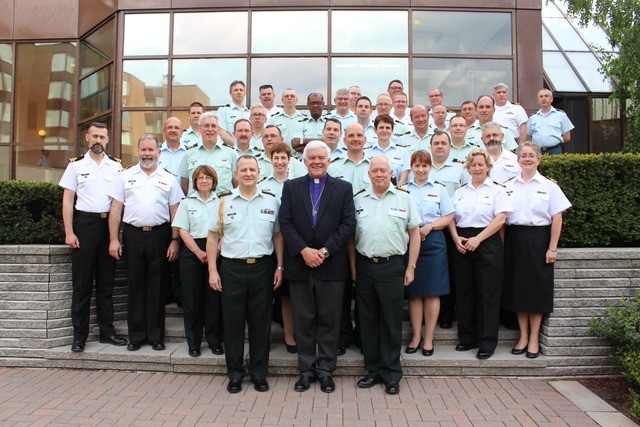
Honourary Captain / Rev. George Alexander Harris. Originally from Solihull, Warwickshire, England, Harris was the Padre to the 1st Canadian Parachute Battalion, and died on D-Day at the age of 34. Details from this site on British Airborne padres.
From In This Sign by H/Major Walter T. Steven, Toronto: The Ryerson Press, 1948.
"H/Captain G.A. Harris had been in the Army less than thirteen months when he was killed-in-action with the 1st Canadian Parachute Battalion on June 7th, 1944. Harris at first had wanted to become a chaplain in the Royal Canadian Navy but when he discovered there was more need in the army, quickly wrote Bishop Wells that he would be glad to serve wherever he was needed. For some time he was attached to the Parachute Battalion at Shilo, Manitoba, and was happy when he was again attached to this unit Overseas. In the ordinary course of his duty Harris was dropped behind the German lines with the Battalion on June 6th, but, like many of his comrades, did not last long against the bitter attack of the enemy.
That he conducted himself gallantly no one could doubt, but we have almost no details about his death. A personal letter from a soldier in hospital to his mother came to the notice of H/Major the Rev. Canon Wm. Askey, E.D., of All Saints Church, Winnipeg, formerly Senior Chaplain, 4th Canadian Armoured Division. This letter told of a report that had reached the writer that the grave of Padre Harris had been found with his identification discs and Bible on it. The losses of the unit were so heavy that it is possible we will never know further details. When he left Camp Shilo for Overseas his Senior Chaplain spoke of him as “one of the most capable and trustworthy chaplains” and as brave in preaching as in other ways. He was an immediate loss to the Chaplain Serivce as, in longer terms, he was to Canon Askey whom he had assisted in All Saints’ Church, and the Church of England generally."

Padre Walter Brown, Chaplain to the Sherbrooke Fusiliers, 2nd Canadian Armoured Brigade, murdered while a prisoner of war, June 7th, 1944.
Again from In This Sign:
"H/Captain W.L. Brown , a former curate of All Saints’ Church, Windsor, Ontario, went to France on D-Day and was missing on the same day. On June 8th a wounded officer was brought in who reported that Padre Walter Brown had been with him on a sortie for wounded men. They ran into a nest of the enemy and Walter was captured. Long afterwards it was discovered that he was one of those prisoners-of-war whose life was forfeit, agaist all the rules of the Geneva Convention, to the whim of a brutal enemy. He was a gallant young man, loved by his men and much appreciated by his fellow chaplains. His Senior Chaplain, H/Major McCleary wrote, “Never will we forget the return of Walter Brown, as those stretcher bearers tenderly brought in his spent body, and on July 11th we buried him in Beny-sur-Mer, in the midst of the lads he loved and served so well. Walter buried the first lad in the corner of this field where we have mad a resting place for so many in the subsequent weeks.
It is a tribute to Brown’s devotion and skill that when it was proposed, before he left Canada, that he be detached from the 2nd Canadian Armoured Brigade and sent overseas with another formation his Brigadier made an earnest request that he stay with the formation, putting up such a good case that the request was granted. He was the sort of chaplain who knew his men intimately and had their confidence and that of the Commander so that he could render his maximum service in that particular Brigade.
Two years later the staff in the office of the Principal Chaplain was proud to go to considerable pains to recover some portions of the Communion set that had been used by H/Captain Brown. As is necessary under battle conditions this equipment had been used by other padres but it was ultimately possible to recover and send to Walter Brown’s mother the chalice and paten that she so wanted to have as a memorial to him."
As a footnote, Padre Brown’s communion set was brought to the Canadian Armed Forces Anglican Chaplain’s Retreat in 2012. It was a great joy to me and to my bears to use his chalice and paten in our Eucharist. I wrote about that occasion here.








